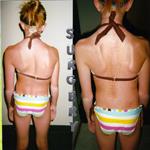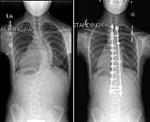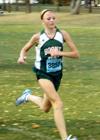Treatment
Patient Story: Scoliosis Treatment With Spinal Fusion Surgery

During a routine sports physical in seventh grade, a doctor noticed twelve-year-old Blaire Benshoof's shoulders were uneven and detected a curvature in her spine. A follow up appointment with her pediatrician and subsequent x-rays confirmed that Blaire had adolescent idiopathic scoliosis, an abnormal curvature of the spine. The most common form of scoliosis is idiopathic, meaning the cause is unknown. Scoliosis, which most frequently appears in adolescent girls, can cause severe deformity and difficulty breathing if not treated.

Idiopathic scoliosis is diagnosed when asymmetry is noticed when bending forward and a spinal curve of 10° or greater is detected. Blaire's spine had a severe 39° curve. Curves exceeding 30° occur in only 0.2% to 0.3% of the population. In August of 2009, a month after her initial diagnosis, Blaire and her family saw Stuart Weinstein, MD, an orthopaedic surgeon at the University of Iowa who specializes in pediatric spinal deformities. Although a common treatment for progressive spinal deformities greater than 25° is bracing, the Benshoofs decided not to put Blaire in a brace.
Eight months later, x-rays revealed that Blaire's spinal curve had progressed to 55°. The deformity was visible, and had started to affect her breathing. Blaire was suffering from frequent backaches and encountering challenges while playing sports, specifically running cross country and track. Dr. Weinstein scheduled Blaire for spinal surgery to correct her rapidly advancing scoliosis.

On July 29, 2010, Dr. Weinstein performed a posterior spinal fusion surgery to correct Blaire's spinal curve and stabilize her spine. A series of rods and screws hold her vertebrae straight and have alleviated the deformities caused by scoliosis.
"Blaire is still doing cross country and track and has added weight lifting," her mother Kim explains. "She has found that there are some moves she cannot do anymore, but she just finds a new way to do them." Blaire does not suffer from backaches anymore and is less winded when running.

"It definitely makes you think about how a simple rod in your back can affect your whole life," Blaire says. "I've learned to live with it and do things I never thought I would be able to do again."
Now fifteen, Blaire is an active teenager who sees her spinal surgery as a mere road bump on her life's journey. She hopes that she will continue to be free of spine problems in the future and advocates for additional research to help slow or stop spinal deformities from progressing to the point of surgical intervention.
Last Reviewed
October 2012
AAOS does not endorse any treatments, procedures, products, or physicians referenced herein. This information is provided as an educational service and is not intended to serve as medical advice. Anyone seeking specific orthopaedic advice or assistance should consult his or her orthopaedic surgeon, or locate one in your area through the AAOS Find an Orthopaedist program on this website.






